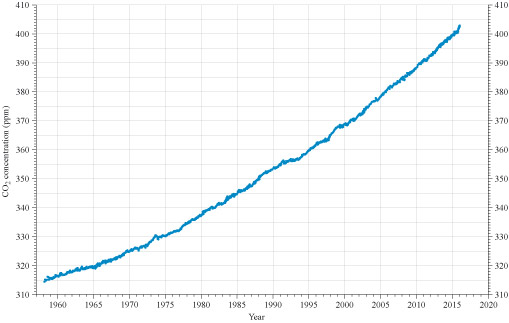3.7 The Keeling Curve
The Keeling Curve, illustrated in Figure 17, shows the trend in rising atmospheric CO2 concentrations since 1958 recorded at Mauna Loa in Hawaii. The story of atmospheric CO2 in those past 60 years is a relentless rise derived from human use of hydrocarbons: in 2008, the annual mean concentration was 383 parts per million (ppm), and eight years later it reached 400 ppm.

When Charles Keeling first collected his CO2 data, he travelled around making the measurements at widely spaced locations – but he saw that apart from the daily and seasonal variation caused by local plant photosynthesis and respiration, the concentration was virtually the same wherever he measured it. Keeling quickly realised that this meant it was possible to measure the CO2 in one location, such as Mauna Loa, and it would be a reference point for the whole planet.
Activity 7 How representative is the Keeling Curve?
Is Keeling’s contention that the Mauna Loa data are a good reference for the whole planet consistent with what you have learned about atmospheric movements?
Discussion
Recall from the discussion of the spread of pollutants by wind (and from your own experience if you live in an exposed area!) that there are constant air movements around the planet. These movements stir up the air and mix it constantly. This constant mixing means that the concentration of CO2 is likely to be similar all over the globe. This sort of questioning as to whether methods and data are plausible is another good example of scientific method.
